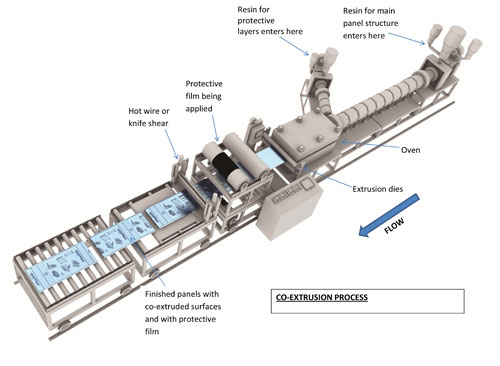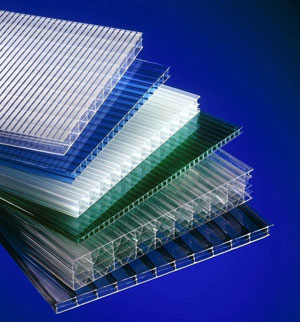Translucent Cellular Polycarbonate Delivers Design Versatility
Extrusion Technology
PCSS is manufactured using extrusion technology. Plastic resin in the form of clear or tinted pellets is melted and pumped through a die. After traveling through the die, the sheets enter a heated oven to relieve tension. They then travel over a series of rollers, are cooled and cut to the final dimensions. This technology allows for the continuous production of any length of product in a wide variety of profiles that is limited only by its ability to be transported. For sheets coming from overseas, the maximum length is 39 ft. That is all that will fit into a 40-ft container. However, manufacturers in the U.S. are beginning to extrude locally and will be bound only by the length of a truck bed.
Key to manufacturing polycarbonate profiles are sophisticated dies that set the width, height, thickness and structure according to the particular specifications of design professionals.
 |
Co-extrusion machines adds a UV protection layer to extruded polycarbonate. Image courtesy of EXTECH/Exterior Technologies, Inc. |
Co-Extrusion Technology
Co-extrusion technology involves adding a thin layer of a different resin mixture to one or both sides of extruded polycarbonate to create different end products. The added material can serve as an ultraviolet light (UV) protection layer since UV rays can discolor unprotected polycarbonate. The co-extruded resin can also serve as a means to color a sheet or as a means to add improved solar heat-rejecting performance.
PCSS Profiles
 |
Cellular polycarbonate structural sheets (PCSS) are manufactured in a variety of profiles. Photo courtesy of EXTECH/Exterior Technologies, Inc. |
All PCSS sheets are flat except for special profiles such as standing seam panels. They are all flexible and can be cold bent to suit design requirements. The length and width of PCSS flat sheeting can be adjusted to meet specific customer requirements. Standard sheeting sizes in the U.S. are 4 ft or 6 ft wide with a maximum length of 39 ft if they are coming by container and longer if they are produced in the U.S. and can be delivered via truck. These lengths are also true for specially profiled sheets such as standing seam or tongue and groove.
PCSS Cellular/Multiwall Flat Sheet
Polycarbonate structural sheets (PCSS) are fabricated in many configurations such as three-wall, five-wall and five-wall x-structure, among others. These multiwall sheets can be used as a standard glazing material and, on rare occasion, can be cut to size on site. Applications include greenhouses and signage (usually 6mm and 8mm thick), office dividers and dropped ceilings (usually 16mm). High-impact or heavy snow/wind load applications, such as curtain walls and skylights, will require panels of 16mm, 20mm, 25mm, 32mm, 40mm or 50mm thickness. These thicker panels also offer higher insulating value.
Standing Seam
Standing seam sheets, commonly used for skylights, canopies and wall systems, are typically available in nominal 2-ft widths. More specifically, owing to their European heritage, they are 600mm (23.62 in.) wide. The available lengths are as stated above for PCSS flat sheets. Typically, standing seam systems have polycarbonate battens, which snap over the sheet edges and form the seams. This is the same design that has made standing seam roofing so successful. Aluminum battens can be used if extra spanning capability is desired. The standing seam panels are secured to the substrate (normally purlins or girts) with metal clips. Some manufacturers offer two-piece metal clips which are designed to accept the thermal movement of the panels as well as reducing noise from friction.
 |
Polycarbonate battens snap PCSS sheets together in a standing seam profile. Hidden clips, which engage the panels at the seams, secure the panels to the substrate. Photo courtesy of EXTECH/Exterior Technologies, Inc. |









